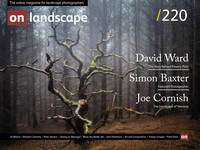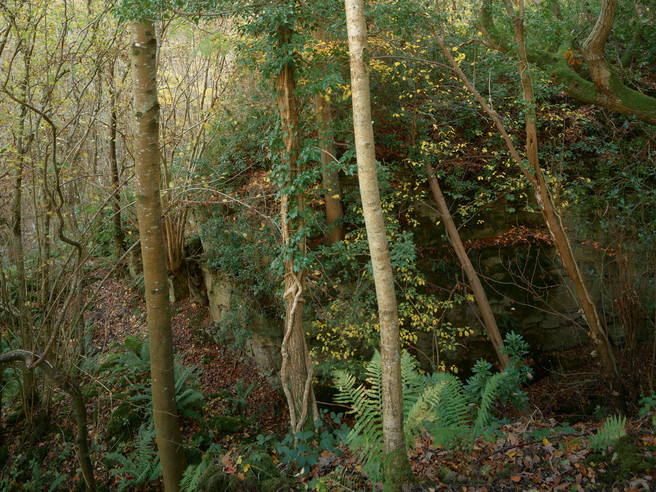The lens of recollection
Before it can ever be a repose for the senses, landscape is a work of the mind. Its scenery is built up as much from strata of memory as from layers of rock. ~ Simon Schama, Landscape and Memory.
Through the months of this year, I have written in On Landscape about some of the different fields of landscape photography. My final theme is the Landscape of Memory. The idea is in part inspired by Simon Schama’s 1995 book, Landscape and Memory. Although potentially controversial, I hope it might be the most interesting – and certainly most embracing – category of all.
Schama’s is the historian’s perspective. He illuminates how landscape – nature – remains a subject of veneration and spiritual renewal in almost all major cultures. This seems to contradict the appearance that, since the industrial revolution, human progress has treated nature merely as a material resource to exploit.
His book is a monumental work that requires days and days of devoted reading…I wish I could claim I had read it all! But the idea is a starting point for the memory of one individual, yours truly, as well as the cultural and collective memory that Schama invokes.
In the course of a life, memories are so numerous they fade, dissolve or change to re-form into narratives that suit our purpose. But, are photographs not in themselves distilled memories? This is highly debatable. Some might argue (Sally Mann for one) that they may even mask or dilute memory… or that they can change it.
My experience is that photographic endeavour deepens engagement and connection with a place and the moment, binding us more closely to it. Memory may then be stimulated, inferred and extrapolated from the image at a later date. But the actualité is probably less important than the imaginative reconstruction it provokes. The empirical truth can never really be retold; everything passes through the filter of memory, the lens of recollection.
I have made thousands of photographs and could tell hundreds of stories about them. Yet a few have ultimately crystallised into something significant…to me at any rate. Whether it is the lessons learned from the individual photograph, or over the period through which the example was made is not so important. Perhaps it is not even about the landscape in the photograph, but these stories are always about the inner landscape, the landscape of memory.
Shotover Valley
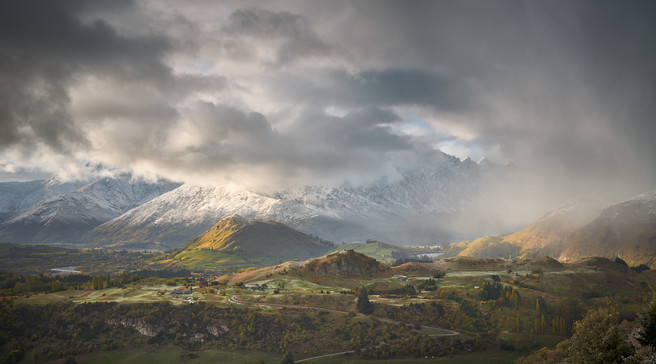
Aged 17 and prior to attending university, I spent 6 months in New Zealand, travelling, and working as a sheep shearer’s roustabout for 3 months.
My father loaned me his Kodak Instamatic for the journey; it was the first time I had ever used a camera. His main reaction to my photographs on returning home was shock at my wanton profligacy. I had shot eighty exposures during those six months. Four rolls of (20 exposure) film would ordinarily have lasted my Dad around eight years.
At such an impressionable age some memories remain, and New Zealand certainly left its mark on me. I travelled widely by car and on foot through the South Island with an old school friend, during and after the work experience. We saw fjords, mountains and glaciers on its west coast, and, in the North Island, thermal wonders and active volcanoes. In many ways this was the epic landscape, still wild in parts, that my youthful imagination would have conjured up as an original Eden. Thirty-five years before The Lord of the Rings film franchise first appeared, there was barely a tourist to be seen.
I returned to the UK in late June 1976, a year of drought. As the train rattled its way from Reading to Exeter through the Wessex countryside, fields and woods already yellowed from lack of rain, I was overcome with emotion. It might have been unusually dry… it was scenically not a patch on New Zealand’s alpine South Island. But it was England; it was home. It must have been the first realisation of my landscape identity.
My brother Nick now lives in Dunedin, and I have visited him a few times since that first journey. The picture here was made in April 2018. Memories of New Zealand are, mainly, happy ones.
But they are not as deep as those of home.
Granite Coast
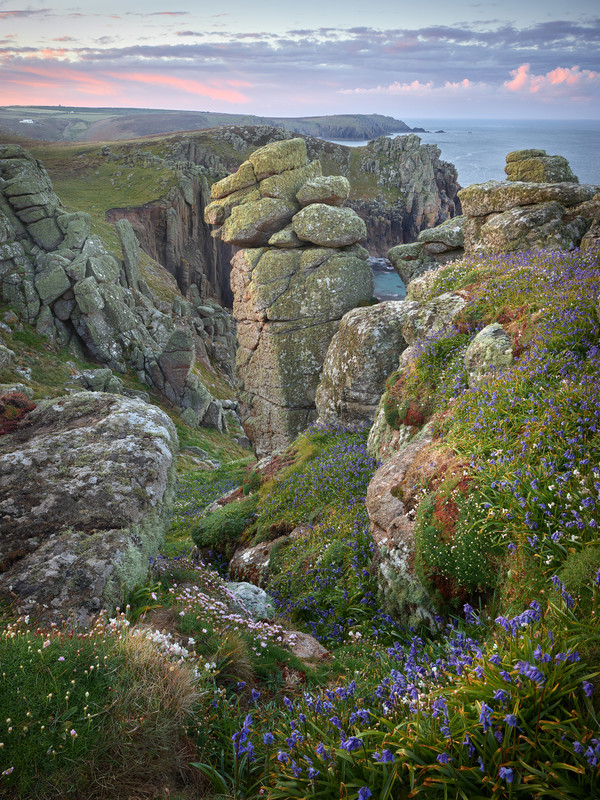
In a moment of mad extravagance, my great-grandfather had splashed out on a holiday bolt-hole in Polzeath, North Cornwall, in 1933. The wildly overpriced, poorly-built house became much loved by his (large and expanding) family over many decades.
As an art student with my first camera (an Eastern European 35mm film slr), Cornwall was the site of my first photographic ideas and experiments. I looked at familiar places with a new, compositionally-critical eye, found myself thinking – worrying – about light and shadow.
Cornwall remains a home from home for me. On returning I carry my many memories. Sharing a name with the county probably helps preserve that sense of belonging too. These monumental, defensive-looking granite ramparts are a mile or so walk south of Land’s End. Framed on all sides except the east by the sea, Cornwall can seem a land apart, and to epitomise what Simon Schama refers to as Britain’s ‘cliff-girt insularity’. But, for me, these mosses, lichens and spring wildflowers evoke a memory of sunlit, warm, life-affirming abundance.
Toledo
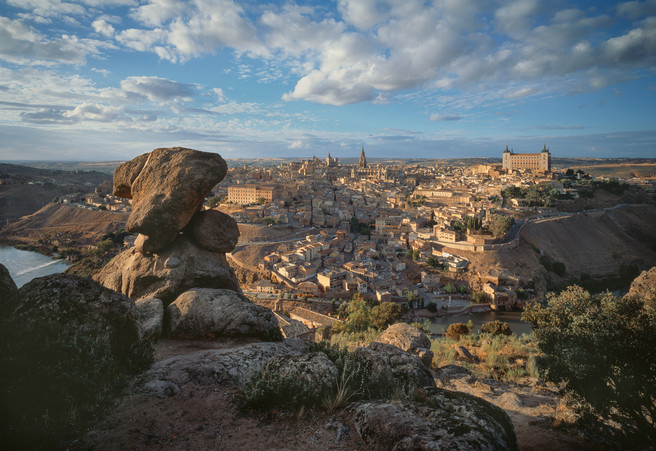
The Greek-born Spanish painter, Doménikos Theotokópoulos, was known as El Greco to the people of his adopted city. He made one of the first pure landscape paintings of the Renaissance; the legendary View of Toledo. This in itself was remarkable, but even more so was his treatment of it. Although based on recognisable topography, El Greco’s trademark brushstrokes made Toledo into a fantastical city, a spiritual domain, dramatised by astonishing effects of light.
Because View of Toledo is such a landmark painting, any art student with a lively interest in art history was/is familiar with it. As a young working photographer I travelled widely in Europe during the late ‘80s and early ‘90s; once I knew Toledo was on my subject list for a book on Castille and Léon, seeking out El Greco’s View of Toledo viewpoint became an obsession.
Whenever we attempt to revisit an older view, everything has inevitably changed. Was this the spot? A cafe owner nearby was keen to reassure me, indeed it was. Having found the place, I returned twice before the light co-operated. Not El Greco’s sky, for his was drawn largely from imagination; but at least one that could evoke depth.
By now the cafe may well have gone, perhaps replaced by a multi-million euro El Greco experience museum. I feel lucky to have found my own perspective on a view El Greco immortalised in the memory of generations of art lovers.
Derwent Water from Kings How
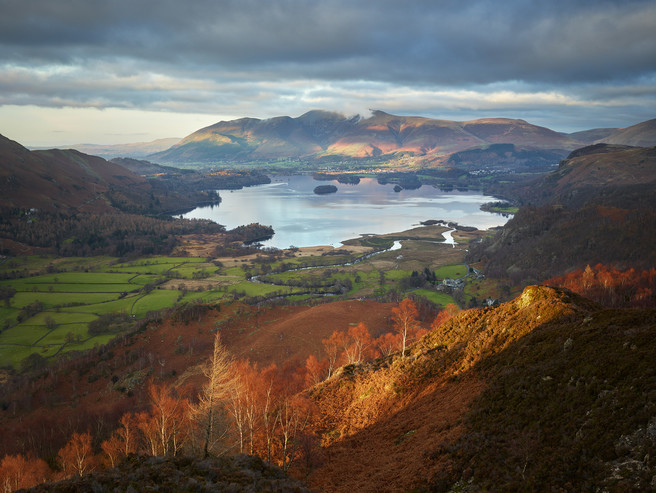
In our loft is a large, faded, painting I made as a 15-year-old, while on an Easter family holiday in the Lake District. It is a detail of a twisted, rough-textured, complex old tree. I cannot recall where the tree was, but I do remember we were based in Keswick.
The first book for which I was the commissioned photographer was about the Founders of the National Trust. Its cover picture was of Brandelhow, the National Trust’s first Lake District property, on Derwent Water. I have continued to return to the northern Lakes, building up my back-catalogue of photographs and memories. For all its popularity I have never tired of the unique synthesis of dramatic fells, sheltered valleys, rivers, lakes and woodlands.
I recall a picture book from my childhood. Straddling two pages, one illustration showed a small girl sitting up in bed, totally absorbed in a picture book of her own. From a patchwork fabric her quilt changed into a patchwork of fields, and the end of her bed was all distant hills and woods, a river system and lake. This was no great work of art, but I love that picture; it proves to me that a feeling for landscape is embedded (no pun intended) in childhood.
The view of Derwent Water from Kings How brings that picture to life in my memory.
Bealach Na Gaoithe
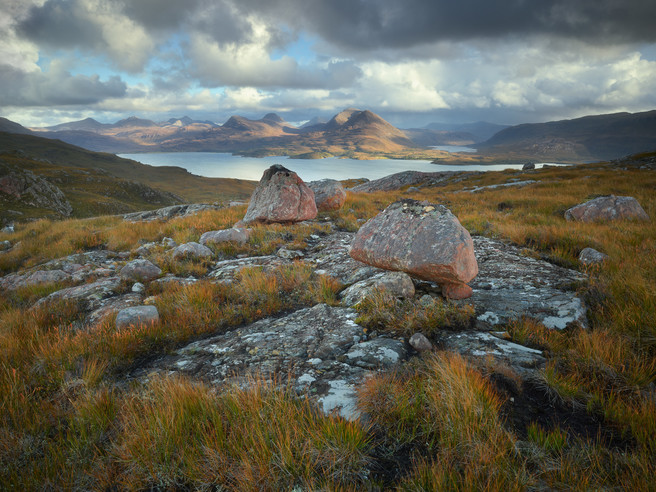
Rarely do I recognise the direct inspiration of another photographer, but inevitably there have been such influences. In my book First Light, there is a chapter entitled, ‘Friends and Heroes’, which highlights those to whom I owe a particular debt. Paul Wakefield is one of those. A hero then, I am happy to also count him a friend now. This composition is a homage to Paul’s dark-yet-sunlit, precisely-seen large format film image from Scotland: A Place of Visions. It remains the iconic original, imprinted in memory.
The great writer Jan Morris collaborated with Paul on this book and others about the British Isles. In the light of her recent passing, and the context of memory, it seems only right to remember and acknowledge her immense contribution to nature and travel writing here.
Scotland’s landscape has been the subject of millions of pages of inspired prose and poetry. As much as any nation can be, Scotland is more than territory. It is also an idea, a land of the imagination, a refuge for the soul. It is a paradox and a contradiction, for although the rain almost always seems to be falling somewhere, the colours are richer, the spaces more sharply defined, and the light more brilliant and elusive than anywhere else I know.
Castleton, Drifting Smoke
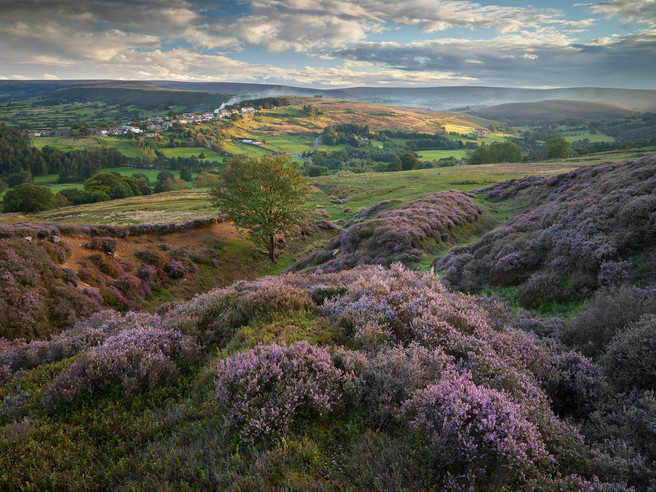
When out and about with my camera I hope to be completely receptive, to respond to what I see and put myself “at the mercy of inspiration” as the Zen mantra has it. But at the same time a working photographer has to consider practicalities. The north of England is the territory of a calendar that I co-publish each year with my gallery, so if the opportunity arises, I am happy to make images with that in mind.
In late summer heather blooms widely on the North York Moors, close to our home. Although really only at its best for a few short weeks, it forms a much-loved and defining signature of the landscape. Each August I seek an image that may prove useful for a future calendar. Over time these wanderings have coloured my memory, reflecting a cultural memory of the Moors, shared by many.
Eigg, Boulder Field
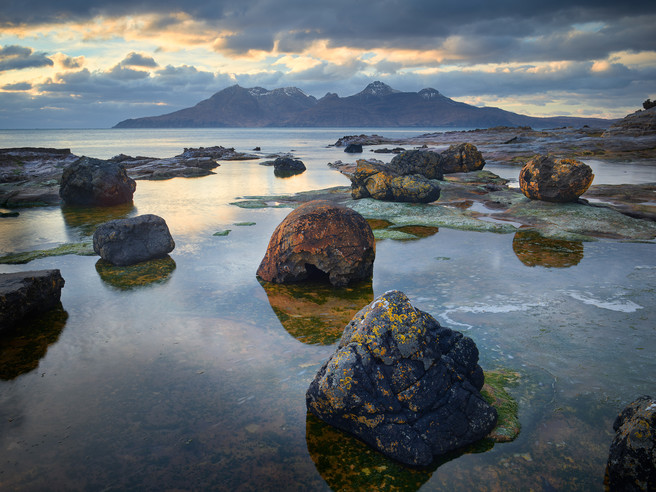
The first book of which I was the literary as well as photographic author was First Light, published in 2002. The cover photograph is from the coast at Elgol, Skye, and its composition pivots around a beautiful, apparently spherical boulder. That unfortunate rock has now developed a certain notoriety among photographers. I owe it my apologies.
At the time it seemed an ideal cover image, combining interesting geology and cloud-wreathed distant mountains. It was shot only a year or two after I had started with a 5x4inch film technical camera, full-time. This picture was a confidence booster – technically and creatively it seemed I was finding my way.
My next book was Scotland’s Coast, published a couple of years later. The cover photograph was shot on Eigg; interesting geology and cloud-wreathed distant mountains again. But that - apparently self-referential picture - was much more challenging to shoot. In my mind it remained a work in progress.
After many years I returned to Eigg in February of 2018, driven in part by memory and a desire to make an image that remained unfulfilled. The combination of elements there is irresistible. The charismatic geology may seem immutable, but the scene changes minute by minute with the tidal ebb and flow, and Hebridean weather. The accompanying image is one composition that starts to get close, but my memory will continue to tempt me back.
Aspens, Independence Pass
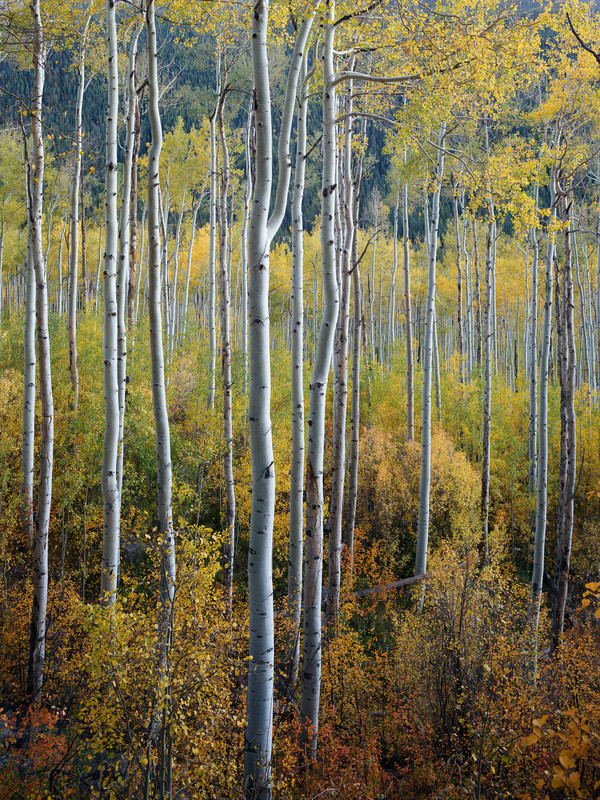
In 2013, thanks to the promptings of Tony Spencer, I found myself in Colorado, co-leading a tour. Tony and I spent a few days before our group’s arrival location-hunting, based on his considerable research. In spite of epic Rocky Mountain perspectives, and the vivid colours of the Badlands we passed, the most memorable spot was a simple aspen grove beside the road below the Independence Pass.
I might have known the geographic location, but at that time I was lost in terms of creative approach. For the preceding five years I had been preoccupied with the new digital workflow, learning to stitch, improving my raw and Photoshop skills, printing my own work, and struggling with the camera. But I had stopped making pictures that I liked.
Independence Pass gave me a photograph I liked… well, loved. It might not have been a big deal; it wasn’t clever, or original. It just distilled some feeling I needed to rediscover. Nothing technical, or spectacular; just pure form and light.
Subsequently, we have always stopped at the same spot with our groups and spent a happy couple of hours beside the road, admiring and photographing these graceful trees. My gratitude and the memory of their ethereal beauty keeps me returning. The image here was made in 2019, reinterpreting the redemption of six years before.
Lost fjord, Greenland
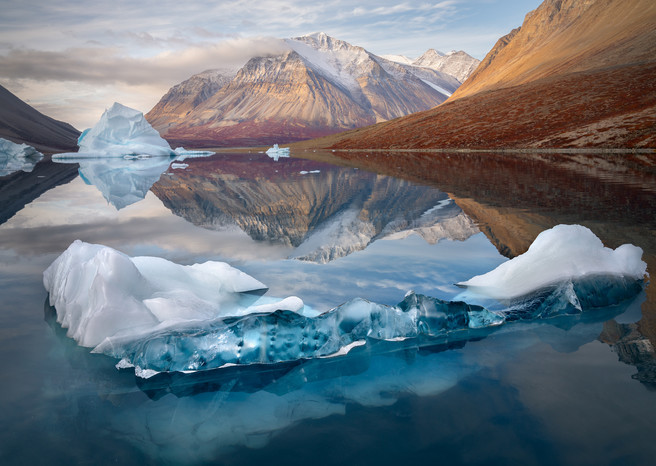
Another Tony Spencer-inspired and organised tour took me to Greenland last year. This was to prove psychologically demanding and utterly exhilarating in equal measure. Every day was a new adventure. On a small (12 passengers) ship we sailed from Svalbard across the Fram Strait, over two days in a storm, to East Greenland. From here we cruised through fjords for almost two weeks, before finally sailing across the Denmark Strait to Akureyri, in northern Iceland.
Deeply sheltered in one of the world’s biggest fjord systems, this day brought light winds and a gently changing sky. The multitude of icebergs grounded in the shallows had to be seen to be believed. Hand-holding the camera in an inflatable boat is usually incredibly challenging, but these conditions made it possible.
Such exceptional memories, shared with a wonderful and convivial group. But the other side to this story is the stark reality of climate change in which fossil fuel-hungry technologies like air and ship travel are implicated. It forces us to question our right to undertake such journeys. Unless carbon emissions reach ‘Net-Zero’ sooner rather than later, coastal environments globally will be subject to an irreversible cycle of flooding and severe erosion.
Eventually, under the onslaught of rising temperatures and sea levels, Greenland’s ice shelves will break up, and her glaciers will no longer reach the sea. And then northern hemisphere icebergs will themselves become mere shadows of memory.
I believe human beings need beauty, and that nature is our source. The ice-filled fjords of Greenland are an inspiration to me, and for now at least I hope I can do more good than harm by making photographs of these fabulous, transient landscapes. To galvanise action, political and personal change, we also need to know – and see – what we may lose.
Abandoned Quarry
My landscape memories of this year have been overwhelmingly connected to a book I’ve been working on about the landscape designer, Humphry Repton. Throughout the summer and autumn and up to the beginning of the November lockdown, in the field and on the essential editing and post-production, it has been this year’s one and only big project.
Working on privately-owned estates I was always socially distanced, staying safe, and doing my job. Every location had extensive woodland providing solitude and the sort of visual challenges I love, including complex visual problem-solving. I have never been more grateful for the opportunity to pursue my chosen profession.
Additionally, this process has strengthened my sense of the vital importance of texture and colour relationships in conveying emotional warmth. The many hours of field work and editing have given me plenty of opportunity to work on that. Finishing in autumn, with its dominant earth tones and colours, was a perfect way to end the process.
This corner of an abandoned quarry, a source of building stone, is now a regenerating woodland. The geological memory that led to its exploitation is mostly concealed, and the workings are barely visible. Nature has reclaimed the present. When sometimes I feel all hope is gone, I try to remember this resilience.
In the end, Landscape of Memory might be called landscape of history; or imagination; or even shadows. In the photographer’s actual experience surrounded by the light, colour, texture and space of reality, there is simply the moment; a living space/time continuum. But there is also the inner landscape, vividly coloured by the landscape of memory. Where the outer world collides, or aligns, with the inner world of the artist, a landscape photograph is born.

